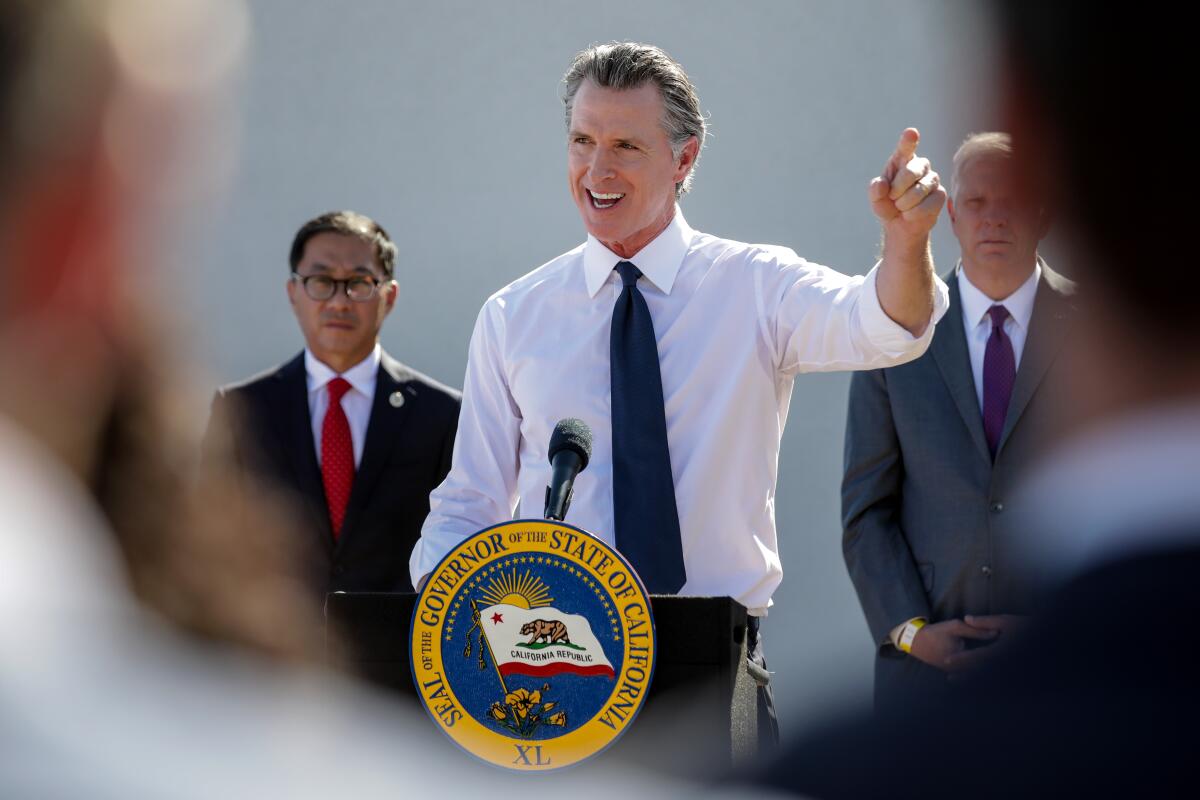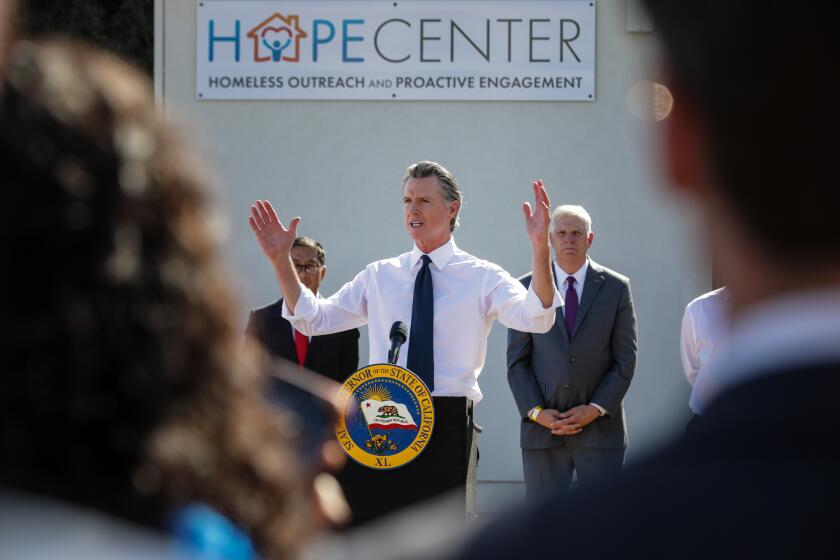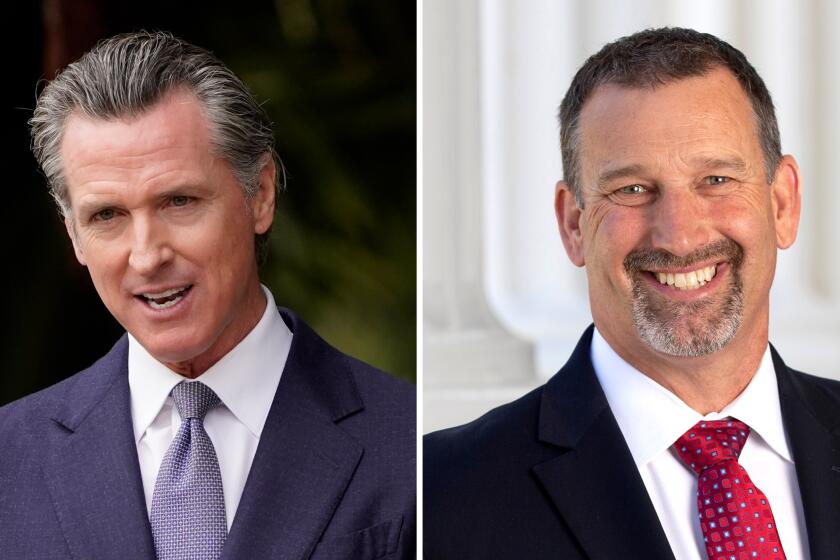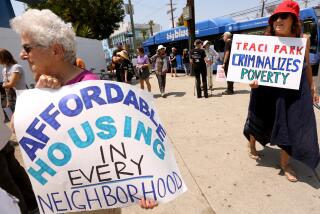Column: Newsom said ‘It’s time to stop pointing fingers and join hands’ on homelessness. That means him too

- Share via
SACRAMENTO — As he approaches a second term, Gov. Gavin Newsom is scolding local governments for failing to conquer homelessness. But he should be pointing his finger in a mirror.
Last week, the governor ripped as “simply unacceptable” homeless action plans prepared by cities and counties. And he froze $1 billion in state money the locals had intended to spend on people who are unhoused.
But there’s a much bigger problem than allegedly weak local plans. It’s the lack of any state plan at all, local officials say.
Newsom has always talked a good game on homelessness. And he and the Legislature have pumped out barrels of state money. But neither the governor nor lawmakers have provided real leadership and guidance on how the money should be spent, the locals assert.
“It’s like an orchestra when no one has the sheet music,” says Graham Knaus, executive director of the California State Assn. of Counties.
“We need to write a score so all levels of government can play their part. That doesn’t exist in California. And we’re going to fail until we have it.”
Jennifer Loving, chief executive of Destination: Home, a nonprofit organization that works with Santa Clara County and the city of San Jose on homelessness, puts it this way:
“Newsom’s frustrated. But he’s kind of like a basketball coach telling his team they all suck without telling them what positions to play, and what plays to run.”
Fiery words flow easily from Newsom — often too easily. He tends to overpromise and underdeliver. He seems sincere, but solutions to homelessness defy emotional rhetoric and good intentions. They’re found in a tangled thicket of complexities requiring a coordinated strategy to make them work. And that has been lacking.
Newsom has been railing about homelessness for years. Moments after being sworn in as governor in January 2019, the Democrat lamented “a homeless epidemic that should keep each and every one of us up at night.”
There were 151,000 homeless Californians then, according to the United States Interagency Council on Homelessness. In 2020, the most recent year for which agency data are available, that number had jumped to 161,000.
In February 2020, Newsom devoted his entire State of the State address to homelessness. That was unprecedented.
“The public has lost patience. You have all lost patience,” he told legislators. “And I have lost patience…. I know homelessness can be solved. This is our calling.”
Gov. Gavin Newsom will announce that he is rejecting local homeless action plans from all 75 state applicants seeking hundreds of millions in funding, demanding higher goals to reduce the number of unsheltered people, and those finding permanent housing.
But around that time, the nonpartisan Legislative Analyst’s Office reported that a Newsom plan to improve mental health treatment for people living on the street “falls short of articulating a clear strategy.”
Newsom has done some good things. He created a state program called Project Homekey to help municipalities buy old motels and apartment buildings to house people.
This year, he pushed through legislation that will force mental health and addiction treatment for unhoused people who are at greatest risk. It’s called CARE Court.
The governor reported last week that the state has spent more than $15 billion on a multiyear effort “to turn the tide on homelessness.”
But unexpectedly, he also acknowledged that “as a state, we are failing to meet the urgency of this moment.”
Newsom was mostly pointing his finger at local governments, however. They were required to submit to him plans for spending $1 billion in state homelessness grants. He complained they were inadequate and held back the money.
“Californians demand accountability and results, not settling for the status quo,” he said in a statement. “Collectively, these plans set a goal to reduce street homelessness 2% statewide by 2024. At this pace, it would take decades to significantly curb homelessness in California.”
With his second-place finish in California’s June primary, Northern California Republican state Sen.
The governor announced he’ll convene a summit of local officials in mid-November to develop “more ambitious action.”
Newsom used much stronger language in an interview with Times columnist Anita Chabria.
“Deliver damn results,” he said, as if lecturing local leaders. “It’s a crisis. Act like it. Everybody step up. I’m not the mayor. You want me to come in? I’ll do the job…. Happily.”
Yes, and what exactly would he do? Maybe we’ll find out at the summit. But I’d be surprised.
Sacramento Mayor Darrell Steinberg, a former state Senate leader who has been battling homelessness for many years, says there needs to be a legal right to housing and mental health treatment.
“When something matters, there has to be some legal obligation behind it or else the system will not respond,” he says. “Moral outrage is not enough.
“People in the most desperate straits living in squalor need to be entitled to care to get them off the street. The public policy should be that nobody lives outdoors.”
Loving says of Newsom: “Instead of treating counties like bad children and acting as an absentee parent, it would be better to work together to create a state plan.”
Everyone I talked to objected to Newsom holding back the money.
“This is not a time to play politics,” says Carolyn Coleman, executive director of the League of California Cities. “Every day we delay getting resources into the community is another day someone does not have the home and services they need.”
Knaus, the counties’ leader, says: “My hope is that this is the beginning of a difficult conversation about who’s responsible for what. So, the state, counties and cities know exactly what they’re supposed to do and are held accountable. We’ve been tripping over ourselves.”
Or, as Newsom said back in his State of the State address on homelessness: “It’s time to stop pointing fingers and join hands.”
That should mean the governor, too.
More to Read
Sign up for Essential California
The most important California stories and recommendations in your inbox every morning.
You may occasionally receive promotional content from the Los Angeles Times.













